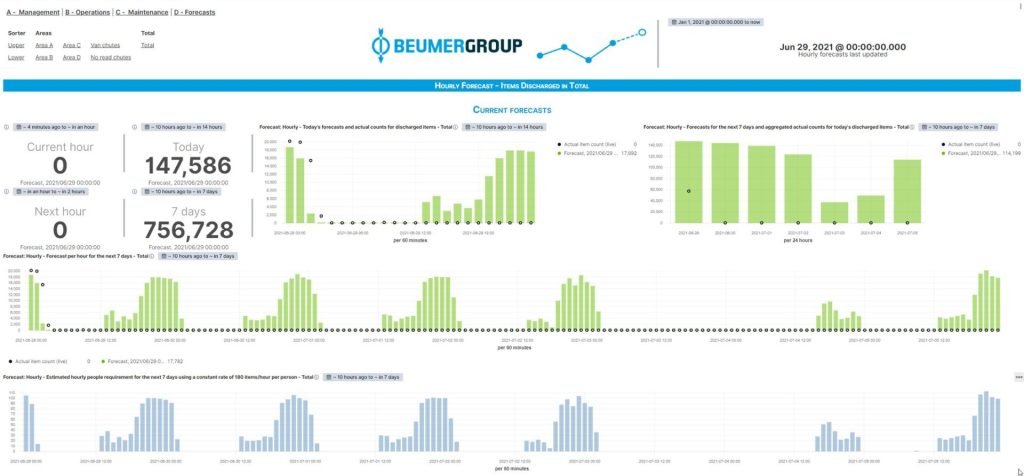Material handling system supervision
In today’s complex fashion logistics operations, facilities are under pressure to optimize their processes for greater efficiency and uninterrupted performance. Imagine a business that has two sites and operates them both in the same way. Yet while one performs well, the other commonly experiences bottlenecks and full chutes in certain areas, causing inevitable recirculation and reducing capacity. What could be causing these problems and what can this logistics business do about it?
Most facilities collect enormous amounts of information from their material handling equipment and operators. Using the right data analytics tools can provide insights into the causes of problems, assist in understanding what is happening at the facility, and indicate how to respond in the future. It can provide an easy and intuitive overview of current operations, upcoming events and maintenance status.
Data analytics tools are critical components for any facility looking for insights into its everyday operations and seeking to improve performance and efficiency by optimizing the use of existing equipment. The tools can also provide information about IT systems and the warehouse control system, such as if a disk is about to become full, the system is overheating, or response rates are slow due to, for example, heavy data traffic.
The day-to-day operations of fulfillment facilities tend to be concerned with two main areas: how well the system is operating and how efficiently orders are processed. For the first of these, involving the mechanical side of the facility, data analytics can provide insights into component failures or threat of failure, breakdowns and replacements. On the operations side, data analytics assists with stock and resources monitoring, and overall operational capacity and efficiency. It gives the unique opportunity to improve operational efficiency without having to make dramatic changes to systems. The facility can enhance performance simply by basing its operations and maintenance on data.
Maintenance assistance
By collecting and analyzing data, over a period of time, asset managers will begin to see trends that can provide information about wear and tear to their components. This is important as the life of any component is affected by operational and environmental conditions, which will differ between facilities. Data analytics enables managers to accurately determine when individual components need to be replaced and whether maintenance cycles can be lengthened.
For example, the analysis of a conveyor sortation system’s vibration data can give information as to the chain’s lubrication status and when the system requires maintenance. Other analysis could send an alarm when certain digital conditions are met, such as an increase in a system’s drive power. The data can clearly indicate a problem that needs further investigation.
Data analytics provides maintenance professionals with clear views of system performance: what is happening, why it is happening and how best to react.
Operational assistance
On the operational side, data analytics can provide visibility into order volumes and structures. This allows managers to determine accurately the numbers and types of resources and workstations needed, as well as identify any requirement for additional operator training.
Consider a fashion warehouse that typically handles large volumes of retail orders. How should its operation be modified to handle a different workload should the need arise? Data analytics can identify the best use of workstations in relation to order structure and the best allocation of operators. Using a data-based strategy, managers can reallocate resources, workstations and packing materials.
Another example is a warehouse that uses a pouch system and wants to ensure that it always has enough empty pouches available to process its orders. In that case, data analytics can assist with ‘housekeeping’ routines and cycles by, for example, providing visibility into the dwell time of returned items stored in its buffers, indicating that they may need to be cleared to make way for immediate orders.
Further applications of data analytics in operations could include monitoring and delivering information on:
- Read rate of RFID tags, ensuring optimal performance.
- The response time of the warehouse control system.
- The load rate on a manual induction workstation, warning of a technical issue or the need for better load sharing.
- Poor induction quality, which can affect tilt-tray and cross-belt sortation systems.
- Events from the unload areas, helping determine whether certain workstations should be added to handle larger orders, smaller orders, etc.
- Server room performance, with alarms warning of events such as a disk about to become full or the system overheating.


Implementation
So how should a fulfillment facility go about implementing data analytics? It’s actually rather straightforward, as long as there is a suitable data-collection infrastructure in the shape of electrical or mechanical sensors that measure physical or electrical values, and an IT system. Then it’s a matter of each organizational unit leveraging the assembled data:
- Base: Most fulfillment businesses are already familiar with data analytics and receive information on basic trends and insights into certain criteria such as induction counts, discharges and discharge failures, re-circulations and alarm counts. More in-depth analysis can deliver insights in real-time and indicate trends over time.
- Maintenance: Maintenance professionals can start to create their maintenance plans based on real-time system data. Efforts will become less about routine schedules and more about focused priorities, leading to more efficient use of staff. Predictive analytics will also minimize the need for reactive repairs and improve maintenance planning.
- Operations: Through data analytics, operations professionals can start to gain deeper understandings of order flows and processes to change, improve and optimize them. They will start to uncover operational inefficiencies and counteract adverse performance effects.
- Management: Management teams will be able to forecast every aspect of their operations, such as order volumes and maintenance needs, and plan for future throughput. With data analytics, management will be able to analyze week-over-week or year-over-year performance, set live site benchmarking and receive automated scheduled reports.
To benefit from data analytics a facility does not need a high level of digital maturity and advanced automated systems, and data analytics SaaS packages can be customized to answer specific inquiries to meet individual requirements. Pricing typically reflects the volume of data and the level of services provided – a facility sorting 100,000 items per day attracts a different rate from one sorting 50,000 or 20,000 items per day.
Conclusion
Data analytics tools, such as those available from BEUMER, can provide an easy and intuitive overview of current operations, upcoming events and maintenance status. They are critical components for any facility looking for insight into its everyday operations and seeking to improve performance and efficiency by optimizing the use of existing equipment.
Author Bio
All pictures provided by BEUMER
This article is powered by BEUMER
- SEO Powered Content & PR Distribution. Get Amplified Today.
- PlatoData.Network Vertical Generative Ai. Empower Yourself. Access Here.
- PlatoAiStream. Web3 Intelligence. Knowledge Amplified. Access Here.
- PlatoESG. Carbon, CleanTech, Energy, Environment, Solar, Waste Management. Access Here.
- PlatoHealth. Biotech and Clinical Trials Intelligence. Access Here.
- Source: https://logisticsmatter.com/how-to-get-the-best-from-your-fulfillment-systems-with-data-analytics/
- :has
- :is
- :not
- 000
- 100
- 20
- 50
- a
- Able
- About
- about IT
- accurately
- actually
- added
- Additional
- advanced
- adverse
- affect
- alarm
- allocation
- allows
- already
- also
- always
- amounts
- an
- analysis
- analytics
- analytics tools
- analyze
- analyzing
- and
- answer
- any
- applications
- ARE
- areas
- arise
- AS
- aspect
- assembled
- asset
- asset-managers
- assist
- assists
- At
- Attracts
- Automated
- available
- based
- basic
- BE
- become
- begin
- benchmarking
- benefit
- BEST
- Better
- between
- both
- business
- businesses
- by
- CAN
- Capacity
- case
- causes
- causing
- certain
- change
- Changes
- clear
- clearly
- collect
- Collecting
- commonly
- complex
- component
- components
- concerned
- conditions
- control
- could
- counteract
- create
- criteria
- critical
- Current
- customized
- cycles
- data
- Data Analytics
- data analytics tools
- day
- day-to-day
- deeper
- deliver
- delivering
- Determine
- differ
- different
- digital
- do
- does
- dramatic
- drive
- due
- dynamic
- each
- easy
- effects
- efficiency
- efficient
- efficiently
- efforts
- empty
- enables
- enhance
- enormous
- enough
- ensure
- ensuring
- environmental
- equipment
- etc
- events
- Every
- everyday
- example
- existing
- Experiences
- facilities
- Facility
- Failure
- familiar
- Fashion
- First
- Flows
- focused
- For
- Forecast
- from
- fulfillment
- full
- further
- future
- Gain
- get
- Give
- gives
- Go
- greater
- handle
- Handles
- Handling
- Happening
- having
- heavy
- helping
- High
- How
- How To
- HTTPS
- identify
- if
- imagine
- immediate
- implementing
- important
- improve
- in
- in-depth
- include
- Increase
- indicate
- indicating
- individual
- induction
- inevitable
- information
- Infrastructure
- Inquiries
- insight
- insights
- into
- intuitive
- investigation
- involving
- issue
- IT
- items
- ITS
- jpg
- large
- larger
- leading
- less
- Level
- leveraging
- Life
- live
- load
- logistics
- Long
- looking
- Main
- maintenance
- make
- management
- Managers
- manual
- material
- materials
- Matter
- maturity
- May..
- measure
- mechanical
- Meet
- met
- modified
- monitoring
- more
- more efficient
- most
- Need
- needed
- needs
- numbers
- of
- on
- ONE
- operates
- operating
- operation
- operational
- Operations
- operator
- operators
- Opportunity
- optimal
- Optimize
- optimizing
- or
- order
- orders
- organizational
- Other
- over
- overall
- overview
- packages
- per
- performance
- performs
- period
- physical
- picture
- Pictures
- plan
- planning
- plans
- plato
- Plato Data Intelligence
- PlatoData
- power
- powered
- predictive
- Predictive Analytics
- pressure
- pricing
- Problem
- problems
- process
- processed
- processes
- professionals
- Profile
- provide
- provided
- provides
- providing
- quality
- Rate
- Rates
- rather
- React
- real-time
- receive
- reducing
- reflects
- relation
- replaced
- Reports
- requirement
- Requirements
- requires
- Resources
- Respond
- response
- retail
- right
- Room
- routine
- SaaS
- same
- scheduled
- Screen
- see
- seeking
- send
- sensors
- Services
- set
- Shape
- sharing
- should
- showing
- side
- simply
- site
- Sites
- slow
- smaller
- specific
- Staff
- start
- Status
- stock
- stored
- straightforward
- Strategy
- structure
- structures
- such
- suitable
- system
- Systems
- teams
- Technical
- that
- The
- The Future
- their
- Them
- then
- There.
- These
- they
- this
- those
- threat
- Through
- throughput
- time
- to
- today’s
- tools
- traffic
- Training
- Trends
- two
- types
- typically
- uncover
- under
- understanding
- unique
- unit
- upcoming
- use
- uses
- using
- Values
- views
- visibility
- volume
- volumes
- wants
- Warehouse
- warning
- Way..
- webp
- WELL
- What
- What is
- when
- whether
- which
- while
- why
- will
- with
- without
- workstation
- yet
- Your
- zephyrnet













